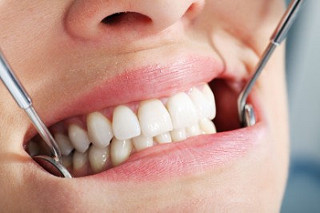ASK THE DENTIST
November 25, 2019

Recent questions from readers answered.
Liz H: I was recently told by a dentist that I need a root canal, a post, periodontal crown lengthening surgery and a crown. The total cost of treatment is $3500! Do I have any alternatives?
That is a difficult question to answer without seeing the specific case but here are some thoughts. There are quite a few things to consider. The first is the general condition of the teeth. If you have numerous other dental problems that need to be addressed, you must prioritize these and decide if the cost of doing them all is something you can afford, or if treatment needs to be spread out over time. The last thing you want to do is spend $3500 on one tooth and then be out of funds to address the other problems.
Let’s assume that this is the only tooth that needs to be addressed. I would look at your past history of dental problems. If you have had limited problems with a low rate of dental decay in general, this treatment may be the best option. If you have had a problem with dental decay, the best alternative might be to extract the tooth and do a dental implant. The cost of the treatment would be about the same and there would be no chance of recurrent problems with decay.
Extracting the tooth and not replacing it can lead to teeth shifting, bite problems and a decrease in function. If the cost of treatment is beyond your means, ask the dentist if there are options to stretch the payment out over a period of time.
Tom Q: My son has been in braces for over a year and has multiple teeth with decay. What should we do?
My first question would be – Why does he have so much decay? Although there are many factors, diet and home care are most likely the culprits for the problem. If the decay can be easily fixed, the diet can be controlled (i.e. decrease sugar intake), and his home care can improve (including a prescription fluoride toothpaste), that would be the best way to go and the braces treatment can move on. If the decay is extensive and his compliance is poor, the best thing to do may be to remove the braces and wait until improved conditions are met before continuing with the braces.
Linda T: My dentist keeps telling me that I need a bunch of crowns. I don’t have any pain and the crowns seem excessive and costly. Why can’t I just wait until something happens and fix the problem when it arises?
You can wait. However, there is probably a good reason the treatment is being suggested. Often, being proactive in replacement of aging large fillings can prevent bigger problems to come. The purpose of a crown in this situation is to protect the tooth. Waiting for “something to happen” can often mean more treatment down the road such as root canals or gum surgery. If you have multiple teeth that need this treatment, ask for a treatment plan to sequence the treatment over time. This is better than waiting.
Each person’s individual situation is different based on things like finances and the value they place on dental health. Ignoring is never a good option.
Dr. St. Clair maintains a private dental practice in Rowley and Newburyport dedicated to health-centered family dentistry. If there are certain topics you would like to see written about or questions you have please email them to him at jpstclair@stclairdmd.com. You can view all previously written columns at www.jpeterstclairdentistry.com/blog.
DON’T SKIP THE DENTIST
November 18, 2019

There was an article written in the The Boston Globe a while back entitled “The Mistakes Doctors Make”…………..and right below that was a column called “Advice for all ages: Don’t skip the dentist.” They were both interesting perspectives.
The dental article starts with, “Earlier this month, a team of researchers from London and the University of Connecticut announced that aggressive treatment of gum disease can improve the function of blood vessel walls in the body, potentially reducing the risk of heart attacks.” The concept is nothing new. We have known for years of the mouth-body connection with health. However, the key to the statement above is “aggressive treatment of gum disease”.
What does aggressive treatment of gum disease mean? It means that instead of watching and waiting for resolution of gum problems on its own, whatever treatment is needed to achieve gum health should be performed.
Periodontal (gum) disease is a silent disease. This means that it does not hurt. Over 75% of the population has some form of periodontal disease. Whether you have early stages of the disease or advanced periodontal involvement, you have periodontal disease. Any form of this disease is potentially affecting your overall systemic health. The goal in any case is to become periodontally healthy, whether it involves simply seeing a dentist more frequently or surgery.
Many dentists tend to watch and wait far too often. “Aggressive treatment of gum disease” means that if the disease is identified, it needs to be addressed. Let’s get it right out in the open – Once you have periodontal disease, and even after it is treated, it will always return unless you follow a strict regimen of home care and professional care…….for your entire life.
Even the smallest amount of inflammation in your mouth is gum disease. Periodontal disease is a chronic inflammatory process. As the article states, “Chronic inflammation anywhere, makes the body release nasty chemicals called cytokines that have been linked to diabetes and heart disease.” It goes on to say, “Cytokines can also trigger inflammation in artery walls, raise blood pressure, worsen cholesterol levels, and increase blood clotting, which can lead to potentially fatal heart attacks.” This also includes strokes. “Pregnancy complications, too, have been linked to gum disease, perhaps because chronic inflammation leads to high levels of a hormone-like substance called prostaglandin E-2, which can induce labor.”
So, what are you waiting for? No one wants to hear that they need treatment for something. It is even harder to get someone to “treat something” that does not hurt and is seemingly not affecting their daily life. The fact of the matter is, periodontal disease is a disease. Diseases need to be treated or they will affect and possibly even end your life. Periodontal disease is no exception. And remember, “aggressive treatment” does not mean watch and wait to see if it goes away. It won’t go away on its own – I promise.
Dr. St. Clair maintains a private dental practice in Rowley and Newburyport dedicated to health-centered family dentistry. If there are certain topics you would like to see written about or questions you have please email them to him at jpstclair@stclairdmd.com. You can view all previously written columns at www.jpeterstclairdentistry.com/blog.
Foods You Shouldn’t and Shouldn’t Eat If You Have Obstructive Sleep Apnea
November 13, 2019

It’s November, which means the holiday season is officially here. Before you know it, your calendar will fill up with holiday parties, work events, and get-togethers with family and friends. At all of these events, there will undoubtedly be lots of sweet treats to indulge in. If you have obstructive sleep apnea, all of this food can actually help alleviate or even exacerbate your disorder. That being said, which foods should you avoid? Which ones should you let yourself enjoy? Below you’ll find a quick guide on foods that affect your sleep apnea.
(more…)EXAMS IN DENTISTRY
November 12, 2019

Diagnosis is the key to success in any area of medicine, including dentistry. Proper diagnosis leads to success in treatment. In dentistry, there are different exams used at different times of a patient’s “career” at the dentist. I would like to clarify some of these in this column.
The Comprehensive Oral Evaluation is the term used to describe the initial exam with a new dentist. For insurance purposes, it is usually paid once in the lifetime of a patient with a single dentist. If a patient does not see the dentist on a regular basis it may be paid for once every 5 years. This evaluation usually is a more detailed exam performed by the dentist. It includes charting of the patient’s teeth (including present/missing teeth and existing restorations), a periodontal exam (to determine the health of the gums and bone that support the teeth), a visual oral cancer screening (a detailed exam of the soft tissues to check for any abnormalities), a review of the patient’s health history (including familial history, medications, etc.), and a general occlusal exam (an evaluation of how the teeth, muscles and TMJ joints are working together). This exam is used as the baseline for where a patient starts in an individual dental practice.
The Periodic Oral Evaluation is the exam that is done in conjunction with visits to the hygienist. For insurance purposes, this exam is usually covered every 6 months. It is separate from the “cleaning” of the teeth. This exam generally looks at the same areas as the previous exam described, but in less detail. The results of this exam are compared to the baseline exam that has been previously completed. Although the exam must be overseen by a dentist, many of the parts of the exam may be performed by the hygienist and reviewed by the dentist.
The Limited Oral Evaluation is the term used to describe an unscheduled visit to the dentist, usually for when a patient presents with a problem. For example, if a patient presents with the chief complaint of a toothache, this exam covers the reading of any necessary dental x-rays and diagnosis of the problem. It may result in the scheduling of the patient for treatment, or referral to a specialist. Different insurance companies have various guidelines for how often they will pay for these visits.
Then there is the underutilized Occlusal Analysis. The reason it is underutilized is because insurance companies generally do not cover it. This is unfortunate, because it serves a very distinct and important role in the diagnosis of many issues that patients encounter. Temporomandibular joint (TMJ) issues, muscular problems, tooth wear/fracture and pre-prosthetic evaluation are all things that could benefit from the occlusal analysis. It is generally a combination of a clinical exam and an evaluation of models of a patient’s teeth, which are mounted on an instrument which simulates the patient’s jaw movements. There are many important things that can be learned from completing this detailed study of the bite relationship, which can lead to much greater success in treating certain patients.
Dr. St. Clair maintains a private dental practice in Rowley and Newburyport dedicated to health-centered family dentistry. If there are certain topics you would like to see written about or questions you have please email them to him at jpstclair@stclairdmd.com. You can view all previously written columns at www.jpeterstclairdentistry.com/blog.
COMMUNICATION IS KEY
November 4, 2019

It is not uncommon to get a second opinion, or a second or third quote for things like car repairs and home improvements. When it comes to our health, it usually depends on the nature of the issue. More complex issues in medicine, such as a diagnosis of cancer, an unknown diagnosis, or other major medical issues in which we have to make decisions about significant treatment, tend to stimulate people to get more than one opinion. In dentistry, it seems that the incidence of second opinions is not as great.
Routine dental care is generally not that complicated. There are many different ways to do the simplest things in dentistry. The method is a function of the dentist’s beliefs and training. It is relatively uncommon for a patient to get a second opinion for this type of maintenance dental care. Although there is some subjectivity as to what different dentists might deem as “needing” to be done, patients usually base their decision on their perceived need. This perception of need comes from the dentist’s ability to communicate the reasons for treatment.
The patient’s trust in their provider is a big factor. If a patient trusts and genuinely likes their dentist, they may not necessarily do or want to do what the dentist wants them to, but they are comfortable enough to make the decision on treatment. It is when there is a lack of trust, for one reason or another, that patients tend to venture out for another opinion. This lack of trust usually stems from a personality conflict or the inability of the dentist to properly communicate with the patient effectively.
Even when there are more complex dental issues, it is my feeling that patients base the need for another opinion on lack of trust. Another important factor is that the patient is given choices. Patients always have the right to choose what treatment they feel is right for themselves. If choices are given and the treatment is properly communicated to the patient, they have the ability to decide in what direction to proceed.
If a dentist properly communicates the need for treatment and the patient decides to do nothing, it is the patient’s choice. It is when treatment is properly presented and it aligns with the patient’s perception of need or desire, that the patient moves forward with treatment.
Fees tend to be a less common reason for patients to seek another opinion. Fees for treatment can definitely vary. The problem with seeking treatment based on fees is that the same treatment in two different offices with different fees can also vary in the level of expertise and precision in which it is done. There are many factors.
A higher fee does not always mean a higher quality product. Fees are generally based on the time involved, the materials used, and the perceived expertise of the provider. Be cautious when seeking treatment based on fees. The fee for treatment should definitely be considered, but the entire treatment presentation and the way in which it is communicated should be used to determine your decision.
Dr. St. Clair maintains a private dental practice in Rowley and Newburyport dedicated to health-centered family dentistry. If there are certain topics you would like to see written about or questions you have please email them to him at jpstclair@stclairdmd.com. You can view all previously written columns at www.jpeterstclairdentistry.com/blog.







